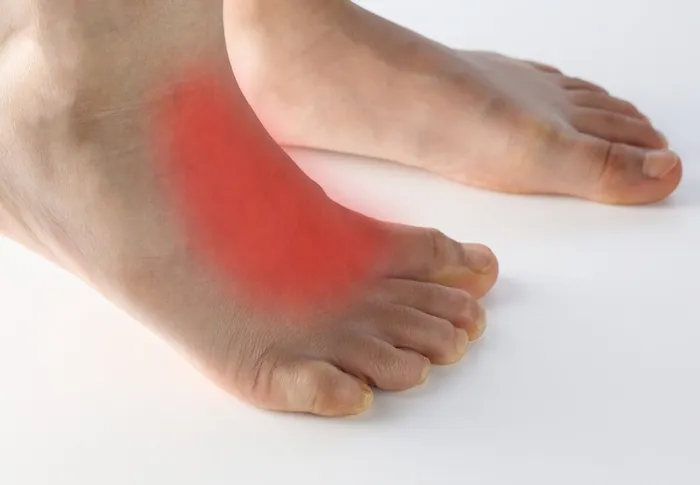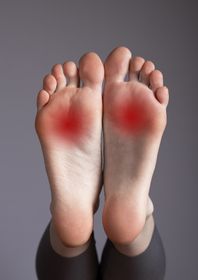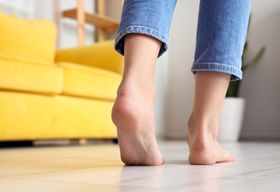Cuboid Syndrome: Symptoms, Causes, Treatments, and Recovery
Updated January 30, 2024.

Cuboid syndrome is the movement of the cuboid bone in the foot to the extent that it shifts out of alignment. This misalignment is usually due to injury or trauma to the foot and can occur gradually with time or rapidly with an acute injury.
You may experience discomfort and pain on the edge of your foot as well as the central areas. The pain is often misdiagnosed due to the complexity of the structures in the foot.
Cuboid syndrome occurs in all populations and ages but is more common in athletes and dancers. Let's consider symptoms, causes, and treatments further.
Common Symptoms of Cuboid Syndrome
Symptoms are usually experienced on the outer or lateral side of the foot, midway between the toes and the heel. Your symptoms can be aggravated with standing or physical activity, while pain is reduced once strain has been taken off your feet.
The symptoms of cuboid syndrome are as follows:
- Dull pain with gradual onset in the foot or sharp, acute pain
- Reduced ability to bear weight on the foot
- Reduced range of motion in the foot and/or ankle
- Pain around the outer side of your foot towards the ankle
- Swelling or bruising associated with acute injury
- Sensitivity on the underside of the central foot
Causes and Risk Factors of Cuboid Syndrome
The causes of cuboid syndrome vary from altered foot biomechanics as seen in flat feet, to overuse and acute injuries that are associated with activities that place great strain on the feet. Therefore, trail runners, dancers, gymnasts, and basketball players commonly experience cuboid syndrome.
Overuse
Running, jumping, or physical activities with side-to-side motions can lead to a shift in the cuboid bone and cause misalignment over time. You will feel discomfort when conducting physical activities. This will get progressively worse as you continue physical activity on a daily basis, but rest will alleviate the symptoms.
Altered Foot Biomechanics
Altered foot biomechanics, as seen in people with flat feet, is a common cause of cuboid syndrome. When you place weight onto the area of the foot where the arch would normally be, it increases the load placed onto the underside of the foot.
Inward Ankle Sprains
In severe cases of inward ankle sprains, the cuboid bone in the foot can be shifted during the impact, because the medial ligaments of the ankle are compromised due to a misstep or twisting action to the ankle. Repetitive ankle sprains can cause an increase in the shift of the cuboid bone and therefore increase pain.
The risk factors for developing this syndrome are as follows:
- Ligament laxity
- Being overweight
- Partaking in activities with repetitive jumping or changing direction
- Wearing shoes with inadequate support, such as high heels
- Running on uneven surfaces
- Not giving your body enough rest between activities
Treatment of Cuboid Syndrome
The treatment of cuboid syndrome involves giving yourself adequate rest between training sessions or physical activities. This will allow localized swelling in the area to subside and reduce your overall experience of symptoms.
Activity modification
Modifying your activity routine is extremely helpful in preventing this condition from progressively getting worse. Refrain from continuing to engage in activities that may aggravate your symptoms and aim to reduce the duration or intensity of your physical exercise if cuboid symptoms are forthcoming.
Ice
Ice can be applied to the underside of the foot in an effort to reduce pain and inflammation in the area.
Orthotics
Orthotics are well documented to provide relief and support to the foot, showing good results over various population groups. For cuboid syndrome, acquiring orthotics with specific padding under the midfoot, where the cuboid bone is located, works to maintain or elevate the arch of the foot, and limit excess supination of the foot.
Orthotics can further be used to manage other conditions that you may be experiencing such as plantar fasciitis, bunions, and burning feet syndrome.
» Flat feet causing your cuboid syndrome? Check out the best insoles for flat feet to help
Recovery From Cuboid Syndrome
Full recovery from cuboid syndrome requires 4-8 weeks, bearing in mind the severity of the initial injury and whether the ankle joint is involved in the injury. In cases where cuboid syndrome has been caused by minor events, it should take a couple of days to notice a change in your symptoms.
Attending physical therapy is extremely helpful in strengthening the muscles of the foot and lower leg, balance retraining, and exercise prescription in an effort to prevent the condition from returning in the future, or progressively worsening.
In Summary
Cuboid syndrome is caused by a misalignment of the cuboid bone in the foot because of an injury and can cause severe pain. The symptoms, causes, and risk factors discussed in this article will help you identify cuboid syndrome. However, always be aware of the risks of self-diagnosis.
Contact a medical professional should you not be able to walk or if the levels of pain are severe. Make sure to take the recovery process and time seriously to prevent the condition from returning or worsening.








